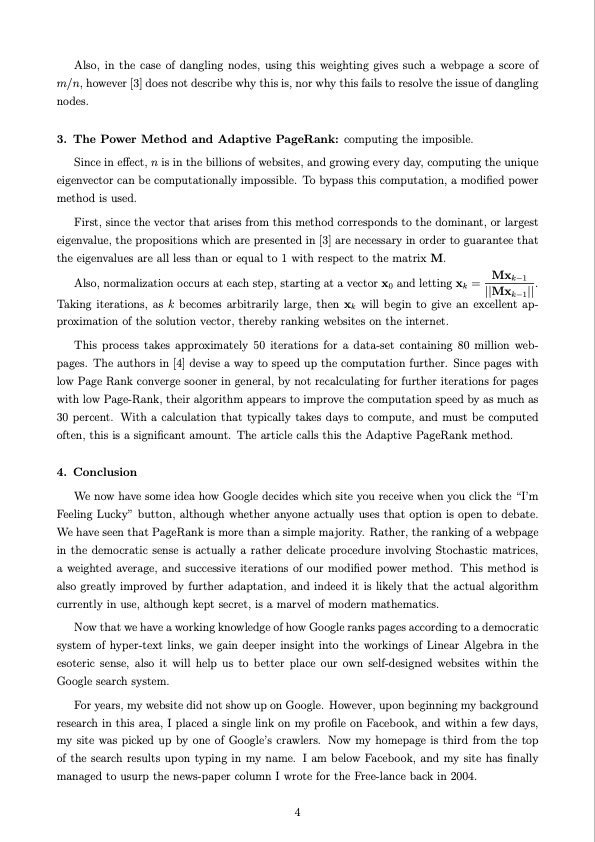
PDF Publication Title:
Text from PDF Page: 004
Also, in the case of dangling nodes, using this weighting gives such a webpage a score of m/n, however [3] does not describe why this is, nor why this fails to resolve the issue of dangling nodes. 3. The Power Method and Adaptive PageRank: computing the imposible. Since in effect, n is in the billions of websites, and growing every day, computing the unique eigenvector can be computationally impossible. To bypass this computation, a modified power method is used. First, since the vector that arises from this method corresponds to the dominant, or largest eigenvalue, the propositions which are presented in [3] are necessary in order to guarantee that the eigenvalues are all less than or equal to 1 with respect to the matrix M. Also, normalization occurs at each step, starting at a vector x0 and letting xk = Mxk−1 . ||Mxk−1|| Taking iterations, as k becomes arbitrarily large, then xk will begin to give an excellent ap- proximation of the solution vector, thereby ranking websites on the internet. This process takes approximately 50 iterations for a data-set containing 80 million web- pages. The authors in [4] devise a way to speed up the computation further. Since pages with low Page Rank converge sooner in general, by not recalculating for further iterations for pages with low Page-Rank, their algorithm appears to improve the computation speed by as much as 30 percent. With a calculation that typically takes days to compute, and must be computed often, this is a significant amount. The article calls this the Adaptive PageRank method. 4. Conclusion We now have some idea how Google decides which site you receive when you click the “I’m Feeling Lucky” button, although whether anyone actually uses that option is open to debate. We have seen that PageRank is more than a simple majority. Rather, the ranking of a webpage in the democratic sense is actually a rather delicate procedure involving Stochastic matrices, a weighted average, and successive iterations of our modified power method. This method is also greatly improved by further adaptation, and indeed it is likely that the actual algorithm currently in use, although kept secret, is a marvel of modern mathematics. Now that we have a working knowledge of how Google ranks pages according to a democratic system of hyper-text links, we gain deeper insight into the workings of Linear Algebra in the esoteric sense, also it will help us to better place our own self-designed websites within the Google search system. For years, my website did not show up on Google. However, upon beginning my background research in this area, I placed a single link on my profile on Facebook, and within a few days, my site was picked up by one of Google’s crawlers. Now my homepage is third from the top of the search results upon typing in my name. I am below Facebook, and my site has finally managed to usurp the news-paper column I wrote for the Free-lance back in 2004. 4PDF Image | Google PageRank algorithm powered by linear algebra

PDF Search Title:
Google PageRank algorithm powered by linear algebraOriginal File Name Searched:
Dynneson_FinalDraft_Linear-Algebra-Project.pdfDIY PDF Search: Google It | Yahoo | Bing
Cruise Ship Reviews | Luxury Resort | Jet | Yacht | and Travel Tech More Info
Cruising Review Topics and Articles More Info
Software based on Filemaker for the travel industry More Info
The Burgenstock Resort: Reviews on CruisingReview website... More Info
Resort Reviews: World Class resorts... More Info
The Riffelalp Resort: Reviews on CruisingReview website... More Info
| CONTACT TEL: 608-238-6001 Email: greg@cruisingreview.com | RSS | AMP |